We arrived at Luxor much later than planned, I think the original plan was to see either Temple of Karnack &/or Luxor Temple when we arrived and then the following morning Valley of the Kings (KV2, KV6, KV14 and KV62) and the Mortuary Temple of Hatshepsut – don’t know why we arrived so much later as everything seemed to be on scheduled leaving Edfu. Our late arrival meant we would have an early start the next morning and see everything in one day. A nice minibus awaited Mahmoud and I (and my bags) the next morning, at 7:00, I’m not an early bird, so I wolfed down my breakfast and we were ready to go.
Valley of the Kings
Before I explain my visit to this captivating and extraordinary (I do not use this word flippantly) place, Mahmoud told me in the minibus that no cameras are allowed inside the Valley of the Kings and that I must leave my camera behind, I didn’t think too much of it because I did have my phone, which is allowed inside. To cut a long story short, too many people were abusing the no photographers without a flash, so they have now banded cameras totally. When you arrive they thoroughly check your bags and if you have a camera they lock it away until you leave, in addition there are at least three guards per tomb, one at the entrance, one at the bottom of the tomb and the other walks up and down. Even if you try to sneak a photo with your phone they can throw you out. So, this time I have no photos and therefore even wracking my brain to its full descriptive and creative capacity would do the Valley of the Kings and the tombs I saw absolutely no justice.

A ticket gives you entrance to three of twelve tombs, and additional ticket is need for each of Tutankhamun’s, Ramesses 6th and Ay. My additional ticket this time (I hope to return) had to be Tutankhamun. The others I saw were Tomb KV2 Ramasses IV (1155 – 1149 BC), Tomb KV6 Ramasses IX (1129 – 1111 BC) and Tomb KV14 a joint tomb of Twosret (1191 – 1189 BC, who just happens to be a woman) and Setnakht (1189 – 1186 BC, Setnakht succeeded Twosret).
As I mentioned and with no exaggeration I’ve been at pains to start this post, I really wished I had just one photo! I may download a few, it’s cheating I know, but you won’t believe how magnificent they are inside.
Ramasses / Ramses / Ramases IV
Reigned for about 6 years between 1151 to 1145 BC or 1155 to 1149 BC and was likely the youngest of five brothers who all died before their father’s death. His father, Ramses III reigned for 31 years plus a few months died as a result of an assassination by one of his wives Tiye, who tried to position her son Pentawer (Ramesses IV half-brother) to succeed Ramesses III…unsuccessfully.
Ramesses’ IV acceded to the thrown in his forties, though his reign was short he was quite busy during his time; sending a few expeditions to Aswan and Sinai quarries for granite and turquoise respectively, and built temples in Sinai too, but realistically you cannot achieve too much within six years.
Tomb KV2
His tomb, follows the same design as those of the same period i.e. a long shaft with a few chambers along with the main burial chamber at the end. This may seem an uncomplicated design, however considering it is cut into mountain and the main shaft is 88.6m long I’d hardly call it simple!

Unlike the pyramid tombs and in fact any of the temples, tombs or anything else I had seen form Ancient Egypt, this tomb and subsequently the t=others I would see in the Valley of the Kings, these are spacious, vibrant and intensely decorated from top to bottom, including the ceiling. I was used to beautifully decorated hieroglyphics cut into the plaster or stone in the temples of Aswan or even the striking decorative scripts of Pharaoh Teti’s pyramid, but these are a kaleidoscope of colour against whitewashed walls exacerbating colours across the walls and ceilings. From inscriptions, deities, wildlife, everyday life, religious scenes painted throughout. Rich gold paint still sparkling are the light from the entrance glistens of it, deep royal blue, cannery yellow, bright bottle green, lush luminous orange, scarlet red and all colours between adorn this and the other spacious tombs – the passageway wide enough to drive a car down (3m wide) and the shaft/corridor ceiling over 3m high. This, and the tombs of the Valley of the Kings are not solemn resting places, no, these are celebratory tombs not only in what is painted on the walls but in their representation of this blast of rich colour throughout.
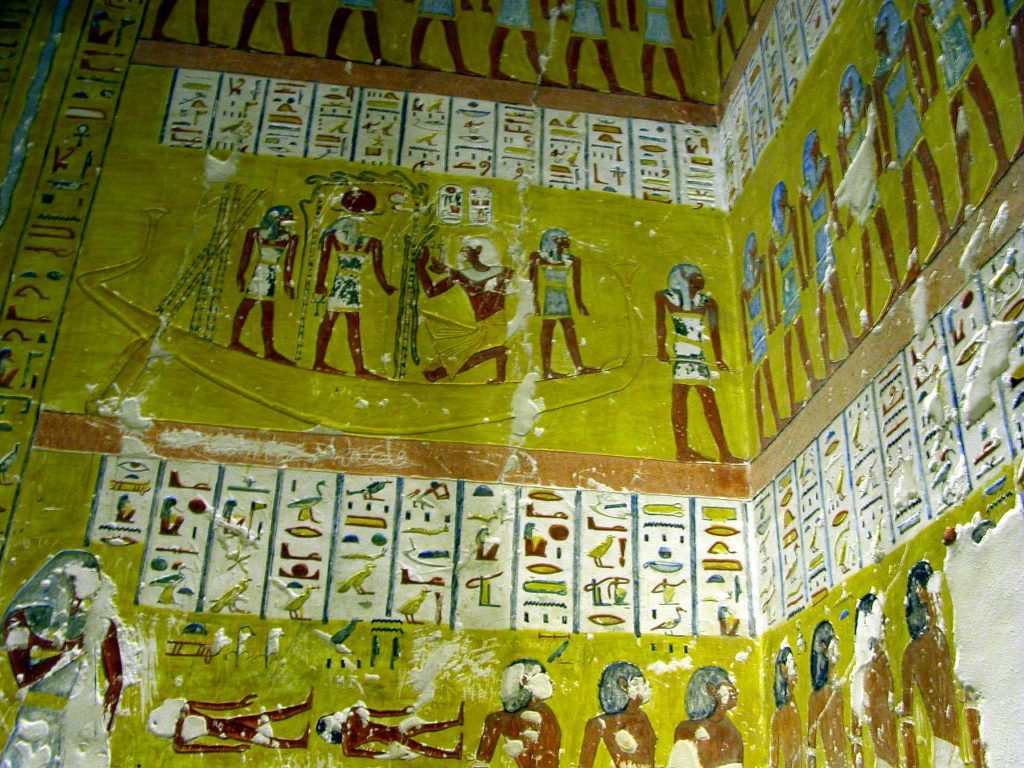
The tomb as with the pyramids had a strong religious function, keeping in mind that the pharaoh was considered a living god there are some unique and prescious scripts within such as Litany of Ra, Book of Caverns, Book of the Dead, Book of Amduat and the Book of the Heavenly Cow.
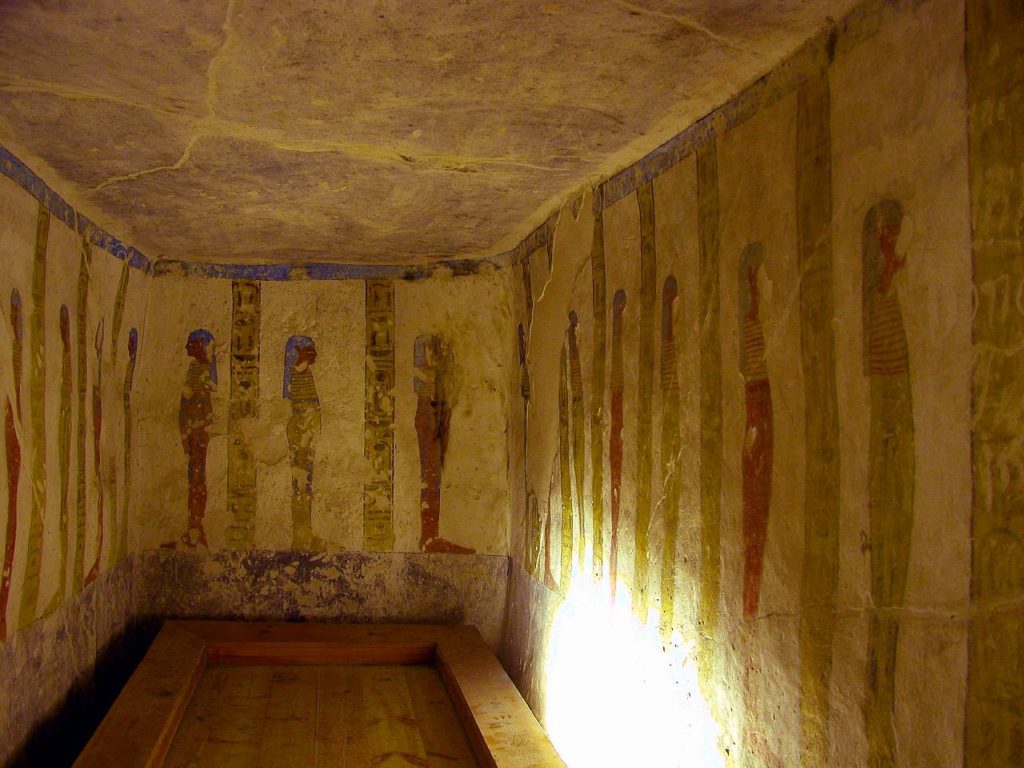
The main shaft consists of three sections each one with a shallow descending gradient, at the end of the third shaft is a large chamber followed by the burial chamber where the sarcophagus is marginally sunken below the floor level. After the burial is a short corridor with three chambers lead off it; one to the left, right and at the front/end. The pink granite sarcophagus is massive, over two metres high and maybe three or four metres long, the lid and base are broken on the one corner, tomb robbers.
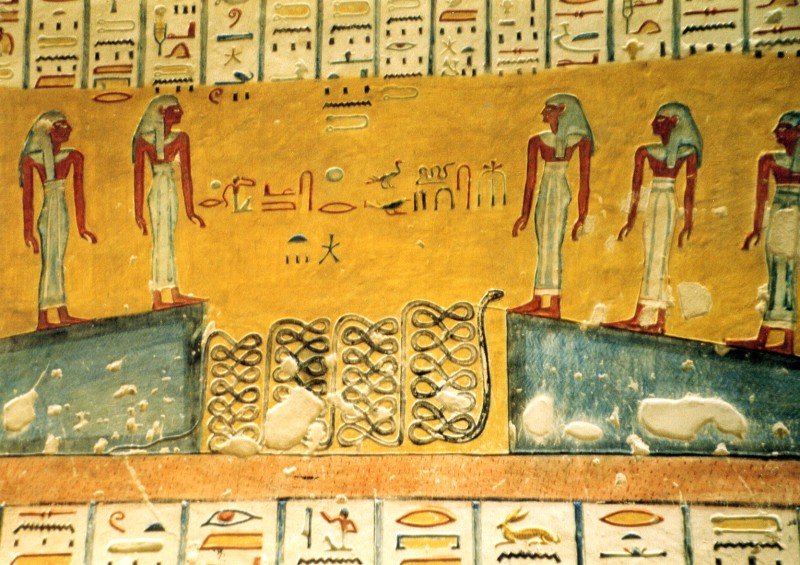
I had to ask Mahmoud a few times jut to clarify that this was indeed the original tomb and not recently restored and painted. The decoration and paint detail could be mistaken as being done recently, as in the past few years, the only tell-tale sign that is near 3000 years old is the various graffiti spanning thousands of years here and there within the tomb (second highest amount of graffiti, the most is in KV9). KV2 has been known about and opened (looted) since antiquity making the condition remarkable in itself having been exposed to centuries of people – there is also strong evidence that Coptic Monks lived inside the tombs for some time.

Having been blown away by KV2 (which is known to be reasonably big but labelled “simplistic”) and at the back of my mind still questioning Mahmoud’s advice that KV2 wasn’t recently painted I also thought that he had shown me the best tomb and the rest would be similar to the grey or stone tombs like those in Giza/Dahshur/Saqqara, oh no who wrong could I be, even later to be told that of those tombs I would see that day they are not near as spectacular is decoration or size of some of the others. Ramasses II tombs has over 70 chambers and in the Valley of the Queens Nefertari is rated as the most beautiful and spectacular tomb within both valleys, a visit to the latter’s tomb cost LE1000 and Mahmoud said it is worth the price!

Ramasses / Ramses / Ramases IX
Ruled between 1129 – 1111 BC was the third longest ruler within the Twentieth Dynasty after Ramassess III and Ramasses XI respectively, Ramasses the IX was almost certainly the grandson of Ramasses III.
Tomb KV6
As with KV2 they are very similar in design with KV6 large at 105m long, even though Ramasses IX reigned for an extended period circa. 18yrs the tomb is unfinished; some niches have no decoration…it might be unfinished, yet it is still spectacular!

The shaft/corridor has three sections each with a slight descending gradient, the first section has two niches on either side which are not finished nor decorated. At the end of the corridors there are three chambers, within the first is a stunning painted scene of the Opening of the Mouth ceremony. The second chamber has four thick columns, the stonework isn’t finished, and they are not decorated either, at the end of this chamber is the burial chamber. There is no sarcophagus but by the shallow outline cut into the ground where it should be you can only guess that it would have been very big!

A vaulted ceiling within the burial chamber has depictions of the goddess Nut; spanning across the whole ceiling is spectacular splendour! The flanking walls with scenes from the Books of Caverns and the Book of the Earth.

It would be arguing about semantics, but this tomb hits the retina with a bang because the colours are set against either white or black, a lot blacker background and outlining is used in this tomb compared to the other tombs in the valley, black along with deep blue and varying vibrant yellow. The dark colours are not overpowering, they are elegantly balanced to make the colours pop and radiate. Simply put, WOW!

For Tomb KV14 I need to add a little background information in order for things to make sense. KV14 is a double tomb, it was originally built by and for Twosret, but appropriated after her death (they think) by Setnakht – whether Twosert was ever buried in the tomb is debatable, but it was most certainly built by her and for her. Custom at the time was for every pharaoh to make his own tomb and be buried there. There are a few hypotheses on where she was buried, and things get more complicated because of jewellery found in KV56 and the cache of royal mummies found in KV35 that were reburied.
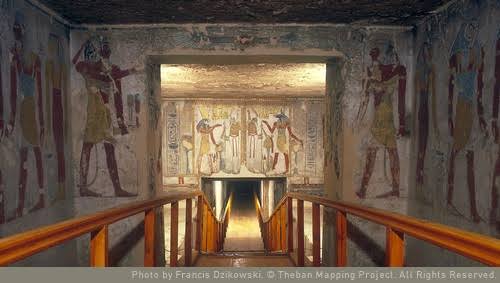
Twosret, Tawosret, Tausret
Died in circa. 1189 BC and is the last Pharaoh of the 19th Dynasty, Twosret was a woman. She ruled jointly as co-regent (but very much in charge) with her stepson Siptah due to his age; he ascended the throne at around 10 yrs old and died about six years later, after which Twosret assumed the full title of Pharaoh only for it to last for one to three years at most before she died – there is some speculation about her death too.
Setnakht, Sethnakht
Had a very short reign from 1189 – 1186 BC and was the first Pharaoh of the 20th Dynasty of the New Kingdom, but set up a long line of Pharaohs starting with his son Ramasses III. Not a lot is known about Setnakht, where he came from or his background, there is a possible connection to Ramasses II in that he may have been one of his grandsons – considering Ramasses II had at least 70 sons.
It seems Setnakht for some reason didn’t like Twosret and neither he nor his son (Ramassess III) recognised or even mentioned her nor Siptah when listing the Pharaohs of the 19th Dynasty. If you include that fact that he took her tomb and within it removed her cartouches and decorated over representations of her (not all her images, maybe he died before they could all be changed), it’s not something you would do to a person you liked! Mahmoud thought it could have been a combination of not liking her, how she came to rule and that she was a woman and woman can’t/shouldn’t be pharaohs let alone be buried in the Valley of the Kings – I think Mahmoud’s theory has traction. Setnakht had started making his own tomb KV11 so it’s even stranger that he used, or was buried in KV14 – to add to this oddity Ramasses III was buried in KV11.

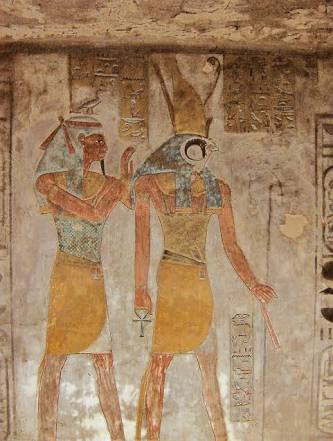
Tomb KV14
It may not be fully completed but no less stunning than the others. Towards the last third of the tomb it is almost just the shell where all the decorations are still marked out in black, including all the script, pictures and scenes; this gives you a unique insight into how the tomb decoration was planned before colour was added. The black outlines are perfect, crisp and sharp edged, nothing like an artist’s rough sketch, these are precise like an architect’s schematic drawing only with artistic flair. Rooms, corridors and chambers reminiscent to a monochrome montage with a minimalist art deco style – a privilege to see the planning of what would have been a masterpiece.
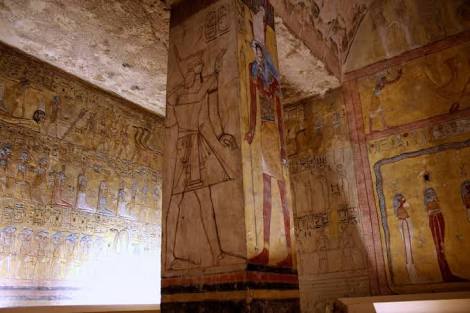
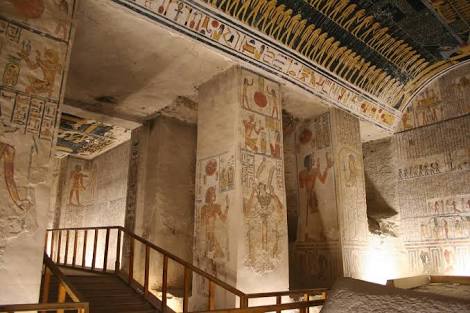
At 112m this is a big tomb and rather different to some of the others, not just because it isn’t finished; it has three burial chambers, the first seems to be the original, the second is an extension where Sernakht sarcophagus was placed and the third is unfinished. As the tomb was made by Twosret many of the pictures of the Queen have been changed to a King and as I mentioned Twosret’s name has been changed to that of Sernakht. There also used to be mentions of Siptah and these have been replaced by Seti II, Siptah’s father. Compared to the previous two tombs I saw KV14 is more complex, with more niches, chambers, annexes, antechambers and the burial chambers are much bigger, and they have columns. As you would expect the tomb has many religious and ritualistic scripts, including Book of the Dead, Opening of the Mouth, Book of Gates and the closing scenes from the Book of Caverns. The show piece to me was the decoration on the ceiling of the first burial chamber, and astronomical chart set on a royal blue background with the chart written in gold, it’s more than a head turner, it really is a rare and magnificent depiction which is quizzical and left me thinking and wanting more answers when I finally stopped staring.
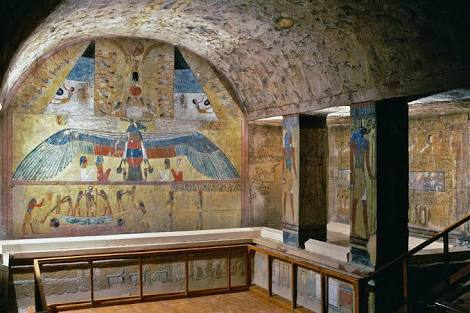

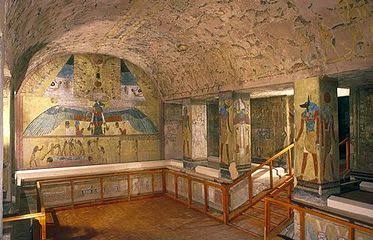
Tomb of Tutankhamen, Tomb KV 62
The most famous of tombs and Pharaohs and I didn’t hesitate to pick his tomb as the additional tomb I wanted to see. Enough has been said and analysed about this tomb so I won’t go into too much specific detail. I was overwhelmed and underwhelmed at the same time, the former because it was a wish from childhood to go see the tomb and the latter feeling because it is distinctly tiny comparted to the other three I saw, but I have no regrets in going to see it…I would go see it again at the drop of a hat!
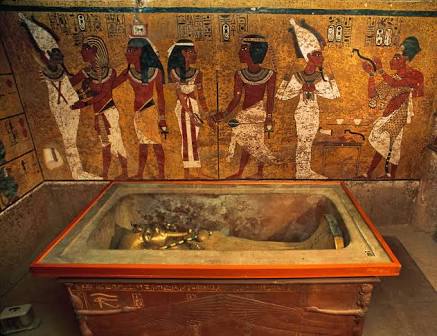
Just briefly, the corridor/shaft is quite small compared to the other tombs I saw, and the descent is much steeper, I could still stand upright when walking down and they have added a wood staircase to prevent wear and tear to the floor. At the bottom of the stairs was the main door made famous by Howard Carter and still had the Royal seal. What I didn’t know is that the tomb had been broken into twice before on separate occasions, after each instance the tomb was resealed.

At the bottom of the shaft is the first chamber, reasonably large and unfinished there is a small antechamber leading of this room to the left and to the right another chamber, the burial chamber; this chamber is sunken maybe about a meter lower and that is where the famous Tutankhamen was laid – off the burial chamber is another antechamber.
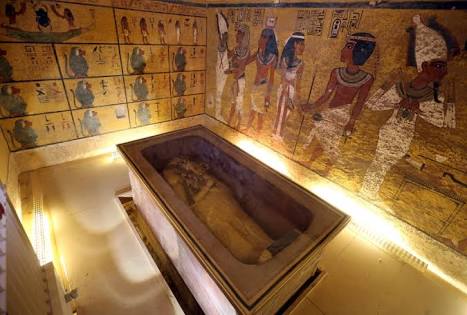
Take a look at my visit to the Cairo Museum where I’ve got some of the items taken out of his tomb, almost 8000 objects were found including the two wood mummiform coffins in gilded gold, the inner coffin 110kg pure gold!
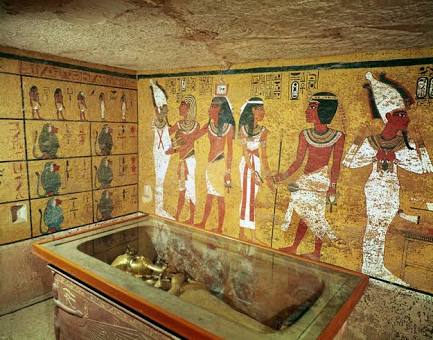
The burial chamber is sparsely decorated and the only room that is decorated, the walls either white or gold and yet still lacking compared to the other tombs, you cannot help ask yourself about the peculiarity in attention to detail, lack of decoration throughout and size of the tomb. I’m no conspiracy theorist and with the recent scans indicating a possible room/chamber/void behind a wall in the burial chamber it lends itself that there may be more this tomb is hiding. Whether or not they find something in this (supposed) void is another question but you don’t need to be a rocket scientist to question the oddities about KV62 when you compare it to all the others within the Valley of the Kings. I LOVE HISTORY AND INTRIGUE! ?
…next stop of the day the Mortuary Temple of Hatshepsut
Or take a look at my previous stop at Edfu and Kom Ombo Temple
